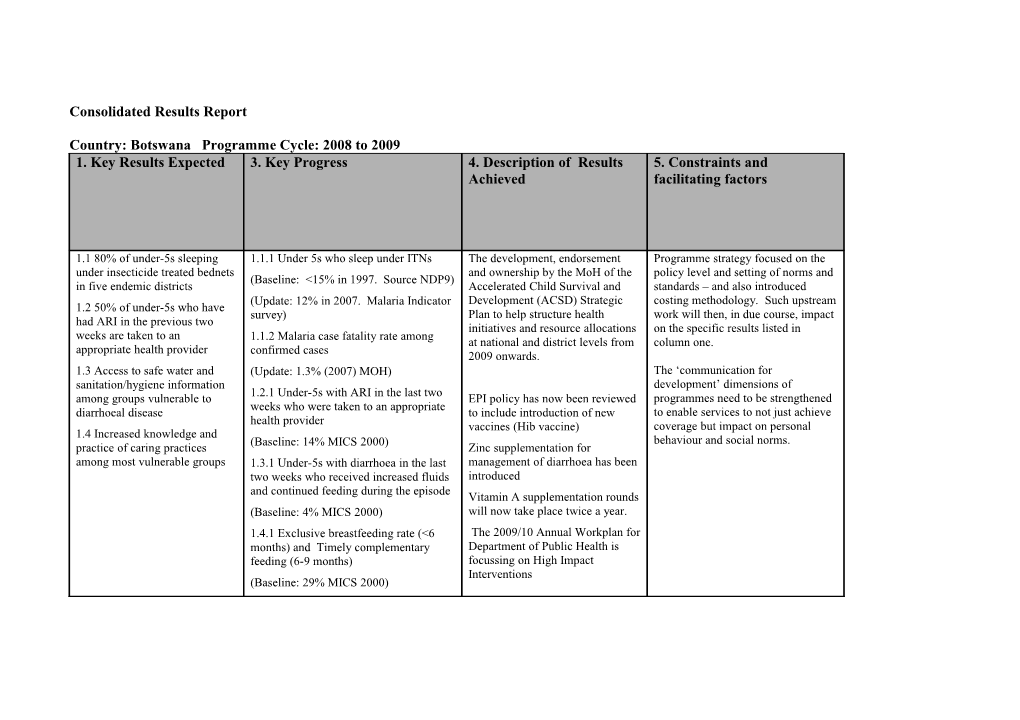Consolidated Results Report
Country: Botswana Programme Cycle: 2008 to 2009
1. Key Results Expected / 3. Key Progress / 4. Description of Results Achieved / 5. Constraints and facilitating factors1.1 80% of under-5s sleeping under insecticide treated bednets in five endemic districts
1.2 50% of under-5s who have had ARI in the previous two weeks are taken to an appropriate health provider
1.3 Access to safe water and sanitation/hygiene information among groups vulnerable to diarrhoeal disease
1.4 Increased knowledge and practice of caring practices among most vulnerable groups / 1.1.1 Under 5s who sleep under ITNs
(Baseline: <15% in 1997. Source NDP9)
(Update: 12% in 2007. Malaria Indicator survey)
1.1.2 Malaria case fatality rate among confirmed cases
(Update: 1.3% (2007) MOH)
1.2.1 Under-5swith ARI in the last two weeks who were taken to an appropriate health provider
(Baseline: 14% MICS 2000)
1.3.1 Under-5s with diarrhoea in the last two weeks who received increased fluids and continued feeding during the episode
(Baseline: 4% MICS 2000)
1.4.1 Exclusive breastfeeding rate (<6 months) and Timely complementary feeding (6-9 months)
(Baseline: 29% MICS 2000) / The development, endorsement and ownership by the MoH of the Accelerated Child Survival and Development (ACSD) Strategic Plan to help structure health initiatives and resource allocations at national and district levels from 2009 onwards.
EPI policy has now been reviewed to include introduction of new vaccines (Hib vaccine)
Zinc supplementation for management of diarrhoea has been introduced
Vitamin A supplementation rounds will now take place twice a year.
The 2009/10 Annual Workplan for Department of Public Health is focussing on High Impact Interventions / Programme strategy focused on the policy level and setting of norms and standards – and also introduced costing methodology. Such upstream work will then, in due course, impact on the specific results listed in column one.
The ‘communication for development’ dimensions of programmes need to be strengthened to enable services to not just achieve coverage but impact on personal behaviour and social norms.
3.1 Universal treatment and care for +ve children
3.2 Universal access to and participation in PMTCT
3.3 Universal acquisition of comprehensive knowledge among primary and secondary school-aged children about HIV/AIDS
3.4 Comprehensive Long Term Plan of Action for the care and support of Orphans and Vulnerable Children (OVCs) / 3.1.1 HIV+ children (U15) who received ARV therapy
(Baseline: 68%: IATT Report 2007)
(Update: 6,872 children aged up to 12 years received ARVs out of an estimated 7000 that need it: 98%, MASA report 2008).
3.2.1 HIV+ pregnant women who received a complete course of ARV prophylaxis to reduce risk of MTCT.
(Baselines: 34% 2002 National Strategic Framework, 90% 2006 PMTCT programme)
(Update: 89%, 2008, Project records)
3.3.1 Males & females aged 7-18 years (and 15-24) who know three main ways of avoiding HIV infection and correctly identify three misconceptions about HIV/AIDS
(Baseline; 29/27% males/females 15-24 yrs, 2004, BAISII)
3.4.1 Long Term Plan of Action on OVCs developed and gazetted.
(Baseline: Short Term Plan of Action on Care of Orphans, 1999)
3.4.2 Households with registered orphans who receive care and support for orphans. / Programme supported consolidation of the PMTCT programme.
Limited progress on knowledge acquisition and HIV prevention among adolescents. National AIDS Coordinating Authority engaged in geographically specific “proof of concept” approach in 2009. / Review identified challenge to move beyond initiation of children onto ART and to support adherence.
Primary prevention acknowledged as the main priority by government and partners.
4.1 Enhanced legal framework for child protection / 4.1.1 Legislative status of proposed revisions to Children’s Act.
(Baseline; Children’s Act under review 2006-7)
(Update: Parliament approved in first session 2009 – Presidential signature pending)
4.1.2 Status of supportive legislation, guidelines, action plans.(see also 3.4)
4.1.3 Under-5s whose births are registered.
(Baseline: 58%, 2000, MICS) / A CRC/ACRWC based children’s Bill has been gazzetted has been presented to Parliament this year. Approved by Parliament (April) and now awaiting Presidential signature.
Birth registration campaign strategy developed with government. / Inadequate understanding of children’s Rights by key public officers and legislators.
Inadequate leadership capacity in key departments such as the Department of Social Services
5.1 Approaches and mechanisms for increased and enhanced participation of children/ youth in decision-making
5.2 Public-access digital resource centre on situation of children and women
5.3 Analysis of key social policy issues. / 5.1.2 Legal status of child./ youth institutions.
5.2.1 Status of public-access digital resource centre on situation of children and women
(Baseline; zero)
5.2.3 Publication of studies and advocacy material / A situation analysis of children and families is on going. / Analysis of data by CSO often lacks disaggregation and timeliness. Identified as a common issue for capacity strengthening in UNDAF 2010-2014.
6.1 Successfulprogrammeapproaches andstrategies documentedin the above MTSPPriority Areas. / 6.1.1.Programmeapproachesdocumented and deemed successful throughexternal evaluations / Limited progress. ACSD approach being documented as good practice.
